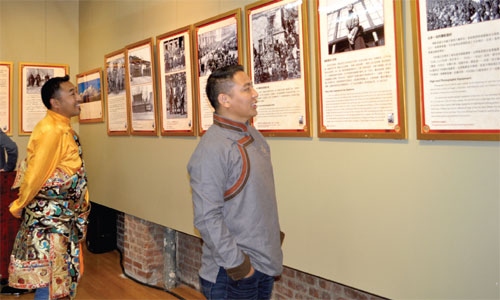Tibet then and now
|
Guests browse the photo exhibition Tibet Through the Lenses of the Tulku and His Son at the Asian Fusion Gallery in New York on Wednesday evening. Hong Xiao / China Daily |
The photography exhibition Tibet through the Lenses of the Tulku and His Son opened on Wednesday at the Asian Cultural Exhibition.
Some 58 photos taken by the father-son team were featured in the show.
The father, Demu Denzin Gyaco, was a revered Tulku, or reincarnated Tibetan Buddhist master, and the first Tibetan photographer. His son Wangjug Doje, is a member of the standing committee of People's Political Consultative Conference of the Tibetan autonomous region and a well-known Tibetan photographer.
Demu Denzin Gyaco's photos depict a wide spectrum of people's lives in Tibet from the 1930s to the 1940s, ranging from the monks to laymen, social customs, traditional culture and religious events.
Wangjug Doje's photos display a wider range of life, including nature conservation, people's entertainment, education and the commercial boom of the recent economic development in modern Tibetan society.
Wangjug Doje said his intention in putting this exhibition together was to "let people understand both the history and the status quo of Tibet".
"There is no definite interpretation of my photos and everyone is invited to have their own understanding of them," he told China Daily.
Most of the photos taken by Demu Denzin Gyaco in the 1930s and 1940s were black and white, while Wangjug Doje's are in color.
Zhang Meifang, China's deputy consul general in New York, said "the colorful photos show the diversified life of the people who are enjoying a more affluent and stable life in modern China, making a sharp contrast to the old black-and-white photos."
Dechen Tulku, President of Tibetan Association of North America, said the exhibition "persuasively exhibits Tibetan's improved life from economic growth".
"People will wake up when they see such soul-touching pictures," he told China Daily. "The photos will be the most convincing evidence to show the fact that Tibet belongs to China and Tibetans are members of the Chinese ethnic family."
"Everything in the photo exhibition is good and makes me homesick," said Jampa Gonpo, a member of Tibetan Association of North America.
Zhang said China will continue to organize various overseas cultural programs to "exhibit the real achievement of Tibetan development" in the foreseeable future.
The exhibit was made possible by the Asian Cultural Center, the New York Association for the Peaceful Unification of China and the Tibetan Association of North America.
Long Yifan in New York contributed to this story.





















